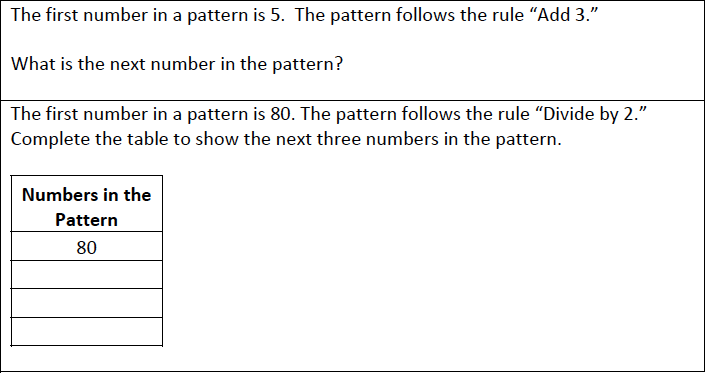Generate a number or shape pattern that follows a given rule. Identify apparent features of the pattern that were not explicit in the rule itself. For example, given the rule “Add 3” and the starting number 1, generate terms in the resulting sequence and observe that the terms appear to alternate between odd and even numbers. Explain informally why the numbers will continue to alternate in this way.
[divider] [/divider]Students are able to…
- Find patterns within their mathematical work.
- Describe and extend patterns.
- Make generalizations about patterns, when appropriate.
[divider] [/divider]Students are able to…because teachers…
- Provide ample opportunities to recognize, extend and describe patterns.
- Help students organize their work to better recognize patterns.
- Facilitate classroom discussion of patterns in words and in writing.
[divider] [/divider]Questions to ask students:
- See if students can correctly identify the next 3 numbers in a pattern when starting with 3 following the rule “add 5”.
- Sample answer that indicates understanding: The next three numbers in the pattern are 8, 13, 18.
- Ask students what features they notice of this pattern:
- Sample answer that indicates understanding: Students could identify the alternating odd and even repetition, growing sequence, or alternating of the digits 8 and 3 in the ones place value.
[divider] [/divider]FSA Notes
Cognitive Complexity Level: 2: Basic Application of Skills & Concepts
Achievement Level Descriptors:
2- extends a number or shape pattern that follows a given one-step rule
3- generates a number or shape pattern that follows a given one-step rule
4- generates a number or shape pattern that follows a given two-step rule
5- identifies and/or explains apparent features that are not explicit in the rule from an observed pattern
Assessment Limits:
Items may only contain whole numbers from 0 to 1,000.
Operations in rules are limited to addition, subtraction, multiplication, and division.
Items may not contain rules that exceed two procedural operations.
Division rules may not require fractional responses.
Rules may not be provided algebraically (e.g., x + 5).
Items must provide the rule.
Context: Allowable
[divider] [/divider]Additional Resources:
Additional in depth content knowledge
Video: Explore patterns that follow a rule
Practice problems with following patterns
[divider] [/divider]Sample Formative Assessment Tasks:

